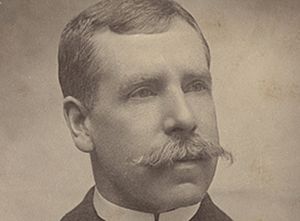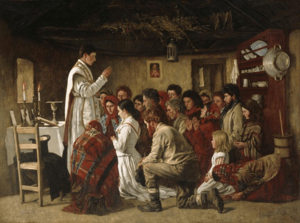Aloysius O'Kelly facts for kids
Quick facts for kids
Aloysius O'Kelly
|
|
|---|---|

Aloysius O'Kelly
|
|
| Born | 3 July 1853 Dublin, Ireland
|
| Died | 12 January 1936 |
| Nationality | Irish |
| Education | École des Beaux-Arts, Paris |
| Known for | Painter, sculptor |
| Movement | Orientalist |
Aloysius O'Kelly (born 3 July 1853 in Dublin, Ireland – died 12 January 1936) was an Irish painter. He was known for his paintings of Irish life and his interest in scenes from the Middle East.
Contents
Early Life and Artistic Beginnings
Aloysius O'Kelly was born in Dublin, Ireland, on July 3, 1853. He was the youngest of four boys and one girl. His family, along with his cousins, the Lawlors, were a group of artists and political activists in Ireland during the 1800s.
Aloysius's grandparents on his father's side were from County Roscommon. His father ran a blacksmith shop and made carts. His uncle on his mother's side, John Lawlor, was a successful sculptor. Aloysius's brothers, Charles and Stephen, also became artists. His oldest brother, James J. O'Kelly, became a successful politician. Aloysius's mother encouraged him to pursue a career in art.
In 1861, Aloysius's father passed away. His mother, Bridget, moved the family to London, England. Her brother, John Lawlor, was already a well-known sculptor there. Lawlor became like a father to the children, especially the boys. He took Aloysius and his brothers on as apprentices in his art studio. This is where Aloysius began to learn about art.
Becoming a Professional Artist
In 1874, O'Kelly traveled to Paris, France, to study art. He enrolled at the École des Beaux-Arts, a famous art school. There, he learned from important teachers like Bonnat and Gérôme. Being accepted into Gérôme's studio was a great honor. However, Gérôme was very strict and tough with his students. Some students found it too difficult to continue. It is not fully clear if O'Kelly finished his studies there.
From Gérôme, O'Kelly became very interested in painting scenes from the "Orient," which often meant countries in the Middle East and North Africa. In 1876, he traveled to Brittany, a region in France. He painted its beautiful coastlines, fishing towns, and small villages.
Art and Politics
Aloysius O'Kelly's art sometimes showed the political events happening in Ireland. In October 1881, Charles Stewart Parnell, a member of Parliament and a leader of the Irish Party, was arrested. He was put in Kilmainham Prison. Just two days later, Aloysius's brother, James J. O'Kelly, was also imprisoned with other Party members. They stayed in prison until May 1882.
During this time, Aloysius created many drawings that showed the political situation. Some of his artworks focused on his brother's time in prison. Aloysius became involved in the political world through his brother. He began to paint and sketch political activists, including members of the Land League, a group that worked for farmers' rights in Ireland.
Later in his life, O'Kelly lived in different places. He spent time in Concarneau, France, and Connemara, Ireland, where he painted scenes of rural life. Eventually, he moved to the United States. In New York City, he painted scenes of city life. He even knew the famous American writer Mark Twain. O'Kelly painted a picture inspired by Twain's character Huckleberry Finn, and Mark Twain himself looked at the painting and shared his thoughts on it.
Aloysius O'Kelly passed away on January 12, 1936, in Poughkeepsie, New York.
Selected Works
- Kitchen, West of Ireland, 1870s
- A Load of Turf, Connemarre, 1870s
- Opening of the New Irish Land Court in Connaught, 1881
- The State of Ireland- Tilling the Farm of an Imprisoned Land Leaguer, 1881
- An Eviction in the West of Ireland, 1881
- The Irish Land League: Recreation time in the Kilmainham Prison, 1881
- Distress in Ireland: Waiting for Relief Outside the Priest's House in Kilronan, 1886
- Edmund O'Donovan as an Oriental, date unknown
See also
- List of Orientalist artists
- Orientalism
Images for kids



